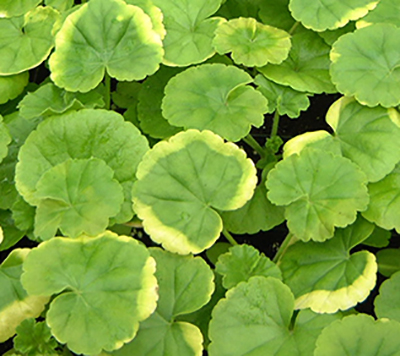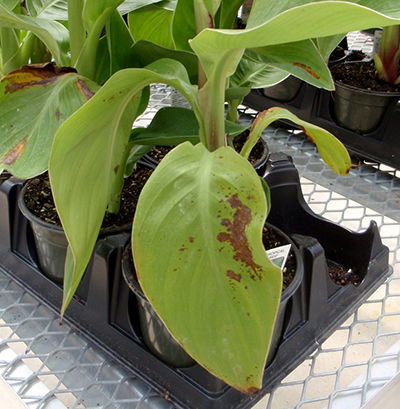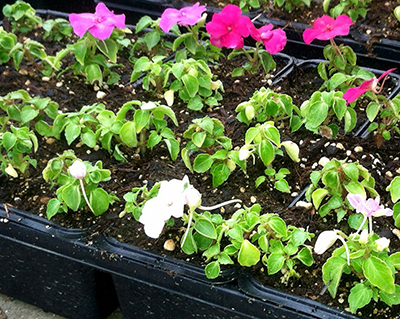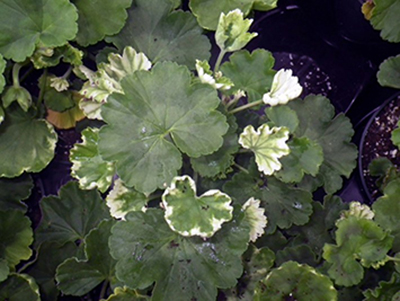Plant phytotoxicity in the greenhouse
What is phytotoxicity and how do you avoid it in your greenhouse?

Many growers use chemicals to control greenhouse pathogens, insect pests or plant growth. However, every chemical applied to plants has the potential to produce phytotoxicity symptoms. In this article, Michigan State University Extension will review what phytotoxicity is and how to prevent it.
Phytotoxicity is simply plant damage – a toxic effect – from something the plant was exposed to. Leaf or flower injury can be caused by a chemical foliar spray or soil drench. Phytotoxicity symptoms may show up as leaf speckling, leaf margin necrosis (browning) or chlorosis (yellowing), brown or yellow leaf spots or patches, leaf cupping or twisting, plant stunting or plant death. The photos below show the different symptoms of phytotoxicity damage on plants.

Geranium leaves with phytotoxicity damage from a plant growth regulator containing chlormequat chloride. Notice the chlorotic (yellow) leaf edges. Many times the yellow leaves will green up in a few weeks and new growth will cover any remaining damage. However, high rates of this product may cause necrotic (brown) leaf areas, which will not recover, except to be covered by new growth. Photo credit: Erik Runkle, MSU

Phytotoxicity (brown necrotic spots on leaves) on canna lily from a plant growth regulator.

Phytotoxicity in the form of leaf cupping and plant stunting on impatiens due to a fungicide overdose.
Phytotoxicity can often be diagnosed by comparing the after-spray new growth of the plant to the older leaves that were sprayed. As plants grow, the damage will remain on the oldest leaves and the new growth will appear healthy. Also, look for damage patterns that match spray patterns. Usually plants located close to the sprayer have more residue than plants further away from the sprayer. While phytotoxicity damage may take several days to a week to appear, it will likely appear all at once and have a regular distribution where the chemical application occurred within the crop. Many times plants will grow out of minor phytotoxicity damage and the new growth will cover the damaged portions of the plant.
To prevent phytotoxicity, be sure to follow the label directions exactly and don’t perform off-label applications. Some plant species, or even varieties within a species, are more sensitive to phytotoxicity than other plants. Be sure to read the chemical label thoroughly before application as a list of sensitive plants or a precautionary statement often appears on the product label. Here is a modified excerpt of an insecticide/miticide label indicating species that are sensitive to the product:
"[This product] is not recommended for use on the following varieties: geraniums (Pelargonium spp.), orchids, hoya, dracaena, cordyline, schefflera, neanthe bella palm, and ferns.
Do not make more than one application per season to hydrangea, impatiens, crotons (Codieum spp.), fuschia hybrids, petunia, peperomia, or cyclamens (Cyclamen spp.)."

This product was used on one of the sensitive species (geranium) mentioned on the label, and phytotoxicity did occur. Photo credit: Dave Smitley, MSU
If you have never used a chemical product before, or never have used it on a particular plant species or variety, it would be prudent to spray a few plants and wait a week to see if there is any plant reaction to the product. Many product labels will include a statement about testing their product first before applying to the entire crop. Here is a modified excerpt of a plant growth regulator label indicating that trialing this product is recommended (in bold) and that growing conditions impact sensitivity to the product.
"Plant response to [this product] is strongly influenced by cultural and environmental variables. Growing media, water/fertilizer management, temperature, light, greenhouse composition, and other cultural practices may impact plant response. Although multiple cultivars have been tested for sensitivity to [this product] and have demonstrated high levels of tolerance, it is impossible to insure an acceptable response in all cultivars. For first time users of [this product], always conduct trials on a limited number of plants to determine crop response."
When the whole crop is treated, it is also helpful to leave some plants untreated. Pull a small group of pots off the bench when you spray, flag them and put them back on the bench after you have sprayed. Later, if some types of plants show unusual symptoms, you can compare them to the unsprayed plants.
Environmental conditions, like light, temperature or humidity, also play a role in the likelihood of plant phytotoxicity (see previous label example above). High temperatures above 80 degrees Fahrenheit are known to increase the occurrence of phytotoxicity. Be sure to apply products in the early part of the day so that the product can dry before the greenhouse heats up. High humidity in the greenhouse has also been shown to increase the chances for plant phytotoxicity because the product applied as a spray is in contact with the plant longer before it dries. As such, be sure to apply sprays in a low humidity environment. In addition, plants that are stressed are more susceptible to chemical injury. For example, do not apply chemicals to a plant that is drought stressed.



 Print
Print Email
Email
